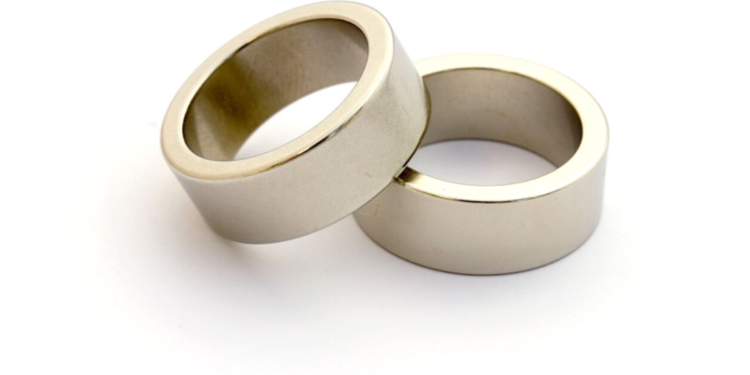A radial ring magnet, also known as a ring magnet or annular magnet, is a type of permanent magnet with a circular shape with a hole in the centre. The magnetization of the ring magnet is perpendicular to the ring’s plane, making it perfect for applications where magnetic flux has to be concentrated in a specific zone. Radial ring magnets have special features that set them apart from other types of magnets.
Radial ring magnets are generally used in various industrial and scientific applications, including motors, generators, magnetic couplings, and sensors. Due to their powerful magnetic fields, they can also be used in medical devices, such as MRI machines and drug delivery systems. Besides this, the potency of a radial ring magnet is determined by its size, shape, and magnetic properties. They can be made from various materials, including neodymium, samarium cobalt, and ferrite.
Features Of Radial Ring Magnet
Radial ring magnets are a distinct type of permanent magnet with a number of special features. They are used in different industrial and scientific applications. In this section, we will discuss the features of radial ring magnets in detail.
- Magnetization Direction
The magnetization direction of a radial ring magnet is perpendicular to the plane of the ring. It means that the magnetic field is focused in the axial direction, which makes it excellent for applications where magnetic flux must be concentrated in a specific area. Moreover, the magnetic field strength of a radial ring magnet is determined by its size, shape, and magnetic properties.
- Shape and Size
China magnets are available in multiple shapes and sizes, depending on their intended usage. They can be circular or oval and have distinct outer and inner diameters. The surface of the magnet also differs depending on the application. Radial ring magnets can range from a few millimetres to several centimetres.
The shape and size of radial ring magnets make them special because they are created to fit specific applications, unlike other magnets.
- Magnetic Properties
Radial ring magnets are made from different magnetic materials, such as neodymium, samarium cobalt, and ferrite. The choice of magnetic material depends on the desired magnetic field strength, operating temperature, and cost.
Neodymium magnets are the strongest and most commonly used radial ring magnets due to their high energy density. Samarium cobalt magnets have a higher operating temperature than neodymium magnets but are less powerful. Ferrite magnets, however, are the most cost-effective but have lower magnetic properties than neodymium and samarium cobalt magnets.
- Magnetic Field Strength
The magnetic field strength of a radial ring magnet is proportional to its size and magnetic material. The most commonly used materials are neodymium, samarium, and ferrite.
The strength of these materials carries depending on the coercivity, cost, and other properties. As we discussed above, neodymium has higher magnetic field strength, but samarium has higher coercivity, while ferrite magnets have a lower magnetic field strength but are the most cost-effective.
- Temperature Dependence
The magnetic properties of radial ring magnets are temperature-dependent. Neodymium magnets have the highest operating temperature of up to 200°C, while samarium cobalt magnets can operate up to 300°C. Ferrite magnets have the lowest operating temperature of up to 150°C. The temperature dependence of radial ring magnets is an important consideration when choosing a magnet for high-temperature applications.
- Coating
Radial ring magnets are coated to protect them from corrosion and wear. The coating can also improve the surface finish and reduce friction between the magnet and other components.
Common coatings include nickel, zinc, epoxy, and gold. Nickel is the most common coating and provides good corrosion resistance. Zinc is less expensive than nickel but has lower corrosion resistance. Epoxy and gold coatings are used in specialized applications requiring high corrosion resistance.
- Application
Radial ring magnets are used in various industrial and scientific applications, such as motors, generators, magnetic couplings, and sensors. Due to their strong magnetic fields, they are also used in medical devices, such as MRI machines and drug delivery systems. Radial ring magnets play a crucial role in technological advancements and are essential for the efficient functioning of various devices.
What Makes Radial Ring Magnets Different From Other Magnets?
Radial ring magnets differ from others due to their unique design and magnetization direction. Unlike other magnets, radial ring magnets’ most special feature is the hole in the centre, which allows for developing a concentrated magnetic field in the axial direction. It is the key element of a radial ring magnet that helps to act on a specific area.
Another factor that sets radial ring magnets apart is their magnetization direction. The magnetization of radial ring magnets is perpendicular to the ring’s plane, creating a strong magnetic field that is concentrated in the axial direction. This contrasts with other magnets, such as bar or disc magnets, with a magnetization direction along their length or thickness.
Lastly, the magnetic properties of radial ring magnets can be tailored to suit specific applications. Different magnetic materials, such as neodymium, samarium cobalt, and ferrite, can achieve different magnetic field strengths and operating temperatures. This versatility in magnetic properties allows radial ring magnets to be used in a wide range of applications, from small sensors to large motors.
Conclusion
Radial ring magnets offer several advantages over other magnets. The hole in the magnet’s centre makes them more efficient and cost-effective, as it reduces weight and volume. Their unique design allows for more customized solutions in various industries. The versatility of magnetic properties in radial ring magnets allows them to be tailored to specific applications, from small sensors to large motors. These features make radial ring magnets an essential component in many modern technologies and will continue to drive technological advancements in the future.
The choice of magnetic material, size, shape, and coating depends on the magnet’s intended use and operating conditions. The unique properties of radial ring magnets make them highly sought after by engineers and scientists alike, and they will continue to play a crucial role in technological advancements in the future.



